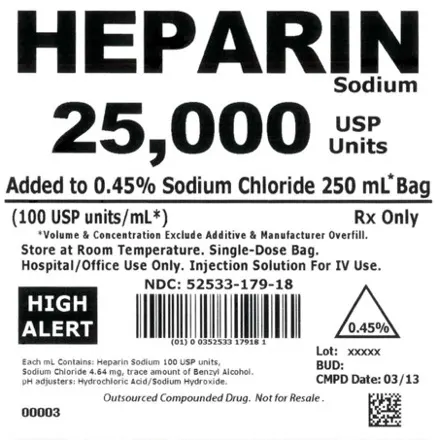
Medication errors pose significant risks to patients. Prevalence of preventable medication harm has been reported to be 9% in humans.1 In veterinary medicine, robust data are less prevalent, so the true incidence of medication errors is unknown. Additional safety precautions (eg, required barcode scanning before administration, electronic medical records with built-in dosage guidelines and interaction alerts) used in human medicine are not typically available in veterinary medicine.
This article discusses standardized medication concentrations and potential adaptability to veterinary medicine, as well as other aspects of error reduction during preparation of injectable medications.
Medication errors may be more likely to occur with injectable medications due to complicated preparation processes (eg, reconstitution with specific diluents, required dilutions) and potential incompatibilities (eg, precipitation due to combination of multiple medications or addition to an incompatible fluid, interactions with polyvinyl chloride IV bags; see Suggested Reading).2 Inconsistent product concentrations and similar package labels can lead to additional confusion during medication ordering and administration.3
Heparin, for example, is available in many concentrations and product sizes. Similarities between the design and wording on drug packaging and in-hospital software can lead to errors. In cases in which only the large writing at the top of the label (Figure) is read, an incorrect product may accidentally be selected, as these products have different concentrations and are in different diluents. Similarly, the wrong option may be selected if these products are listed in the software as Heparin 25,000 units/250 mL 1/2NS and Heparin 25,000 units/500 mL D5W.

FIGURE
Example of similarities in medication packaging that can lead to medication errors. Images courtesy of Standardize 4 Safety
The Standardize 4 Safety Initiative
Standardized medication concentrations are being developed in human medicine, primarily through the Standardize 4 Safety initiative led by the American Society of Health-System Pharmacists with the purpose of creating and implementing standardized medication concentrations for use across all human healthcare facilities. The goals of the initiative are to increase patient safety and reduce medication errors during the transition from one healthcare setting or provider to another (ie, transition of care); for example, patient transfer from an emergency department to an intensive care unit or from a hospital room to a hospice care facility.4
Some of these proposed medication concentrations are commercially available, but others require dilution. Standardization of concentrations can help reduce errors caused by miscalculation during medication preparation because the dilution would stay the same and can simplify medication ordering and increase provider efficiency by decreasing the number of prescribable products and preparation concentrations.
American Society of Health-System Pharmacists has published 3 national standards lists for parenteral medications (ie, Adult Continuous Infusion, Pediatric Continuous Infusion, Patient Controlled Analgesia and Epidural Standards) that contain recommendations for standard drug concentrations and dosage units determined primarily based on potential patient needs (eg, fluid status) and commercial availability (eg, for use of commercially available products instead of compounded products when possible; Table).5 Only 1 concentration per medication was selected when feasible. If multiple concentrations were required, concentrations in multiples of 10 were avoided to further reduce calculation errors. Look-alike/sound-alike medications (eg, norepinephrine and epinephrine) were assigned different concentrations to aid in differentiation.
Although transitions of care still occur in veterinary medicine, especially in teaching facilities and larger hospitals, most care is delivered at one primary location with the same pharmacy or staff preparing all medications. In these cases, implementation of standardized medication concentrations is valuable for reducing errors caused by calculation mistakes (see Calculating a Dobutamine CRI).
Quiz: Math Every Veterinarian Should Master
Mastering medical mathematics can decrease dosage mistakes. Use this quiz to learn various equations and help determine dosages.
Calculating a Dobutamine CRI
An 11-lb (5-kg) cat requires treatment with dobutamine (2-5 micrograms/kg/minute CRI for 24 hours). A dobutamine 12.5 mg/mL injectable solution is available in the clinic.
Example 1: Nonstandard Concentration
Per the product insert, dobutamine should be diluted to a maximum concentration of 5 mg/mL.7 According to the product specifications, the clinic’s syringe pumps can reliably deliver a minimum volume of 0.8 mL/hour. 5% dextrose is determined to be used as the diluent.
The dose needed for a 24-hour supply can be calculated.
Higher dose (5 micrograms/kg/minute) = (5 micrograms/kg/minute) × 24 hours × (60 minutes/hour) × 5 kg = 36,000 micrograms
Once the maximum dose (36 mg) is determined, the maximum dobutamine concentration (5 mg/mL) is used to calculate the required dilution volume (ie, maximum dose divided by the maximum dobutamine concentration). The smallest diluted volume could be 7.2 mL; however, that volume is too small for the clinic infusion pumps to deliver accurately over 24 hours. A larger dilution will be needed.
The total volume needed, considering the infusion pump minimum rate and the ratio of possible doses, can be calculated. This calculation provides the total volume needed if the maximum dose were to be given over the full 24 hours and determines that the minimum dose will be delivered by the minimum flow rate (eg, 0.8 mL/hour will deliver 2 micrograms/kg/minute).
Total volume = minimum flow rate × (high dose/low dose) × duration
Total volume = (0.8 mL/hour) × (5 micrograms/kg/minute ÷ 2 micrograms/kg/minute) × 24 hours = 48 mL
This volume creates a concentration of 0.75 mg/mL (36 mg/48 mL), which is <5 mg/mL, so treatment can proceed.
Based on the capabilities of the clinic infusion pump, the minimum infusion flow rate (0.8 mL/hour) is known, and (based on the previous calculation) administering 0.8 mL/hour will deliver a dose of 2 micrograms/kg/minute.
(0.75 mg/mL) ˟ (0.8 mL/hour) ÷ (60 minutes/hour) ÷ 5 kg = 2 micrograms/kg/minute
The flow rate necessary to provide the higher dose of 5 micrograms/kg/minute must also be determined.
Upper flow rate = minimum flow rate × (high dose/low dose)
Upper flow rate = (0.8 mL/hour) × (5 micrograms/kg/minute ÷ 2 micrograms/kg/minute) = 2 mL/hour
The medication should be prepared by diluting 36,000 micrograms of dobutamine (2.88 mL of dobutamine 12.5 mg/mL) to 48 mL total with 5% dextrose, resulting in a 0.75 mg/mL concentration. After consulting an appropriate resource (eg, the medication package insert, other resources [see Suggested Reading]), an expiration date of 24 hours can be determined after medication is prepared.
If the solution is administered at a rate of 0.8 to 2 mL/hour, 2 to 5 micrograms/kg/minute will be delivered.
Example 2: Standard Concentration
Compounding recipes with detailed instructions for preparation (eg, required diluent, expiration dating) are available in the clinic for dobutamine in standardized concentrations of 600 micrograms/mL, 2 mg/mL, and 5 mg/mL.
For the 11-lb (5-kg) cat described in Example 1, the maximum dose of dobutamine for 24 hours can be calculated.
Higher dose (5 micrograms/kg/minute) = (5 micrograms/kg/minute) × 24 hours × (60 minutes/hour) × 5 kg = 36,000 micrograms
Relevant patient factors (eg, required total dose, fluid status) and clinic equipment limitations (eg, fluid pump minimum flow rates) should be considered when selecting a standardized concentration of dobutamine. For this example, the 600 micrograms/mL concentration is selected and prepared according to the clinic’s instructions.
To determine the rates of administration, calculations should be performed as would be done to determine the rate of administration of any other prediluted injectable medication (see Pharmaceutical Calculations for Injectable Medications).
Using the 600 micrograms/mL standard concentration, 2 to 5 micrograms/kg/minute will be delivered if the solution is administered at rates of 1 to 2.5 mL/hour.
Standardized concentrations may benefit veterinary clinics with multiple locations, especially when staff work across different sites, as having a consistent process can reduce errors. Standardization can also increase staff efficiency by reducing the number of calculations required to prepare medication.
Veterinary clinics typically stock fewer commercially available medications compared with human hospitals, lowering the risk for prescription of an incorrect product, but treat a wider variety of patients (eg, species, weight), which can pose additional challenges when standardizing concentrations. A single set of standard concentrations for all veterinary patients is likely not feasible, but standardized concentrations may be created for species groups (eg, small animal, large animal, exotic). Alternatively, clinic-specific standardized concentrations may be helpful for staff familiar with their typical patient population and can assign appropriate concentrations.
Injectable Medication Errors
In addition to creating standardized concentrations, medication errors during injectable medication preparation can also be prevented. A full understanding of pharmaceutical calculations is needed to ensure safe medication preparation and compounding (see Pharmaceutical Calculations for Injectable Medications). Regular practice can make pharmaceutical calculations easier to perform under pressure.
Pharmaceutical Calculations for Injectable Medications
Percent Strength
For injectable preparations, percent strength is usually expressed as percent weight in volume, in which the percent strength is equal to the weight in grams of medication per 100 mL of liquid.
Percent strength (percent weight in volume) = grams of medication/100 mL of liquid
For example, a 1% ivermectin solution contains 1 g of ivermectin per 100 mL of solution (10 mg/mL ivermectin).
1% ivermectin = 1 gram ivermectin/100 mL of solution = 10 mg ivermectin/1 mL solution
IV Infusions
Determining infusion rates may involve several calculations. If the dose per unit time and drug concentration are known, the infusion rate can be calculated. Units must be consistent between dose and drug concentration.
Infusion rate (mL/hour) = (patient weight [kg] × dose [micrograms/kg/minute] × 60 minutes/hour) ÷ drug concentration (micrograms/mL)
Example:
A 99-lb (45-kg) dog requires lidocaine (50 micrograms/kg/minute). A 2% lidocaine solution is available in the clinic. The infusion rate can be calculated.
Infusion rate = (45 kg × 50 micrograms/kg/minute × 60 minutes/hour) ÷ (20,000 micrograms/mL) = 6.75 mL/hour
Alternatively, if the total infusion volume needed during a specific unit of time has already been calculated, simple division can be used.
Infusion rate (mL/hour) = (infusion volume [mL]) ÷ (infusion time [hour])
Example:
A 9-lb (4-kg) dog requires a 24-hour supply of metoclopramide (2 mg/kg/day IV CRI). Metoclopramide injectable solution is available as a 5 mg/mL concentration.
Daily dose = 2 mg/kg × 4 kg = 8 mg
Daily volume = 8 mg ÷ 5 mg/mL = 1.6 mL
Infusion rate = 1.6 mL/24 hours = 0.07 mL/hour
If the clinic syringe pump has flow-rate minimums, the dose must be diluted to at least the minimum volume. For example, if the syringe pump reliably delivers a minimum of 1 mL/hour, the dose should be diluted to at least 24 mL.
Final concentration of metoclopramide = 8 mg/24 mL diluted solution = 0.33 mg/mL
Infusion rate (per syringe pump minimum) = 1 mL/hour
Aseptic Technique
Aseptic technique, including use of environmental controls, necessary personal hygiene, and PPE,6 prevents contamination by microorganisms and must be used when preparing a sterile product.
Medication Compatibility
Compatibility of injectable medications depends on several factors, including drug concentration, diluent, and storage container and conditions. When preparing injectable products and dilution is required, care should be taken to ensure the medication is diluted to an appropriate concentration with a compatible diluent. Compatibility may differ based on how the drug is prepared and/or used (eg, as a solution additive, via coadministration at a Y-site, mixed with other medication in a syringe).
Storage, Handling, & Labeling
Medications should be labeled with information about the contents and stored (eg, refrigerated, protected from light) according the medication package insert or as recommended by other trustworthy sources (see Suggested Reading). Appropriate beyond-use dates should be assigned.
Conclusion
As demonstrated in human medicine, creating standardized concentrations is an option for reducing calculation errors during medication preparation while also increasing staff efficiency. When combined with other factors (eg, regular practice of pharmaceutical calculations, use of proper aseptic technique, assurance of medication compatibility, appropriate storage and labeling of medications), medication errors can be reduced.
All staff members can take measures to increase safety and improve patient outcomes.
Quiz: Handling Hazardous Drugs
Challenge yourself with this quick quiz on hazardous medications, and discover whether your protocols align with current National Institute for Occupational Safety and Health guidance.